Report on Manufacturing Systems and Processes at Rolls-Royce
VerifiedAdded on 2020/07/22
|10
|3272
|201
Report
AI Summary
This report provides a comprehensive overview of manufacturing systems and processes, with a specific focus on their application within the Rolls-Royce company. It begins with an introduction to manufacturing systems and the operational context of Rolls-Royce, followed by a detailed examination of historical advancements in the automotive industry, particularly the Ford assembly line and the Toyota production system, highlighting their impact on efficiency and quality. The report then delves into various tools and techniques, including statistical process control, lean manufacturing principles, and methodologies like SMED, 5S, and JIT, discussing their roles in enhancing productivity and reducing waste. Furthermore, it explores the implementation of Total Quality Management (TQM) and Total Productive Maintenance (TPM) to maintain product and service quality. The report concludes with a discussion on the adoption of green technology and its associated costs and benefits for Rolls-Royce. The report aims to provide insights into how Rolls-Royce can optimize its manufacturing processes to improve performance and maintain a competitive edge. The content is valuable for students seeking to understand the complexities of modern manufacturing systems, with past papers and solved assignments available on Desklib.
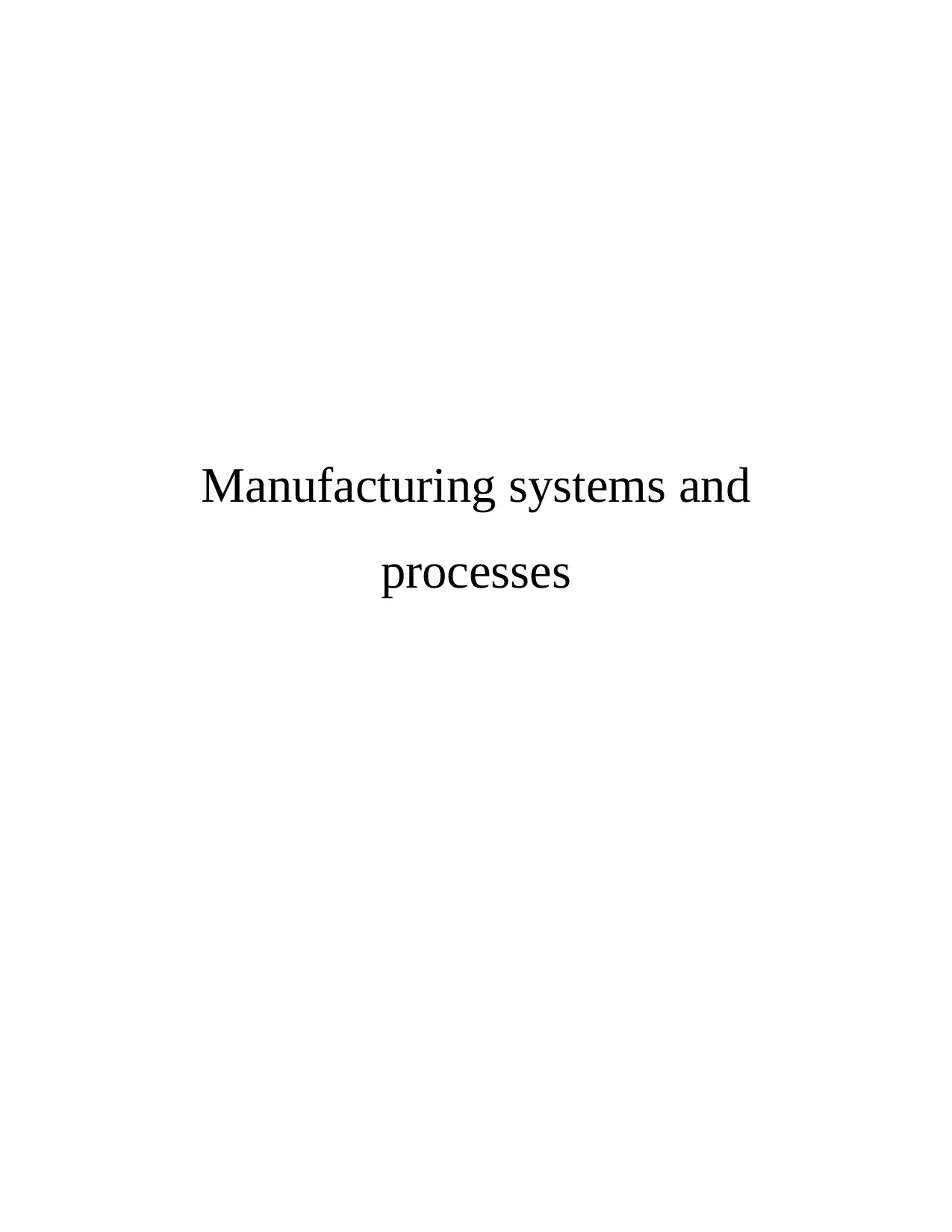
Manufacturing systems and
processes
processes
Paraphrase This Document
Need a fresh take? Get an instant paraphrase of this document with our AI Paraphraser
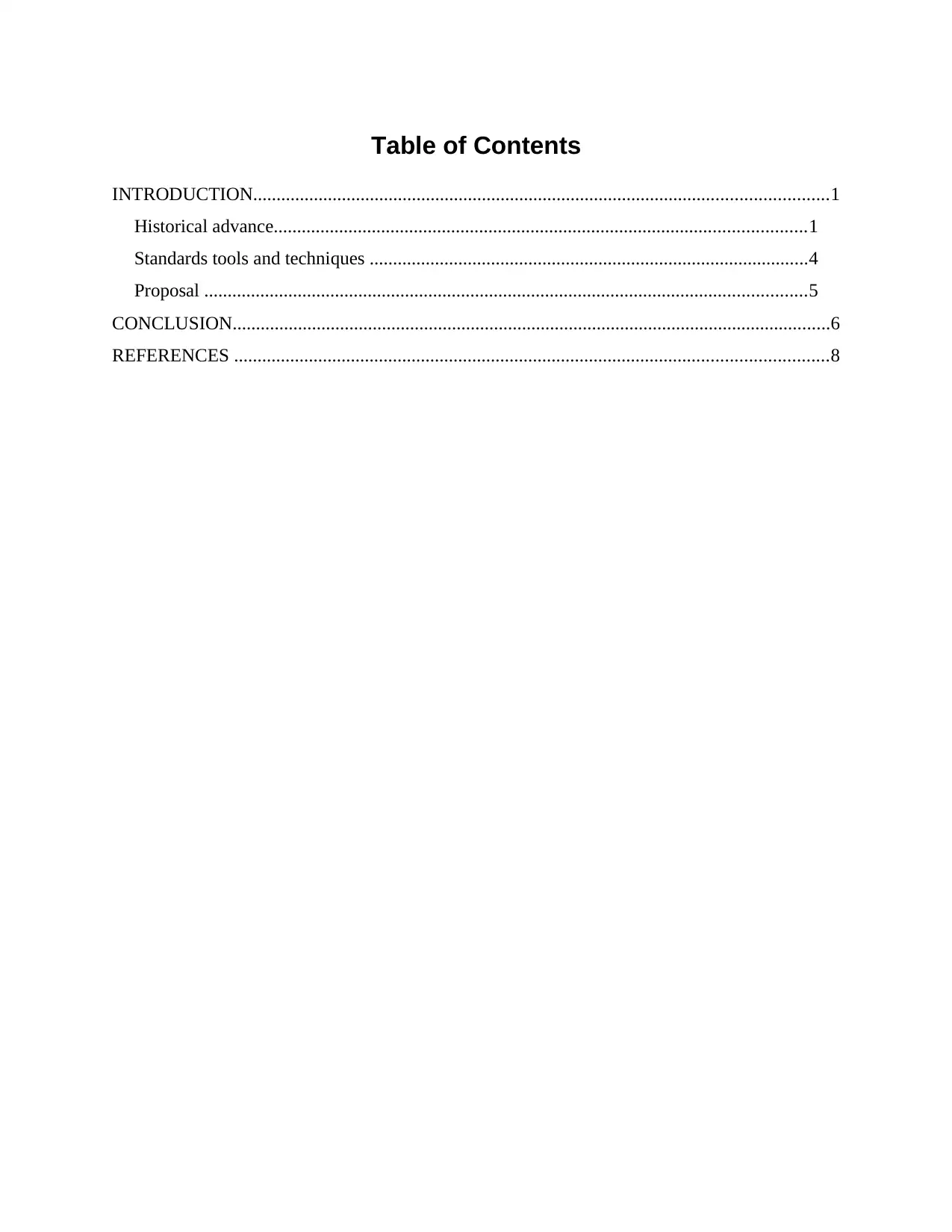
Table of Contents
INTRODUCTION...........................................................................................................................1
Historical advance..................................................................................................................1
Standards tools and techniques ..............................................................................................4
Proposal .................................................................................................................................5
CONCLUSION................................................................................................................................6
REFERENCES ...............................................................................................................................8
INTRODUCTION...........................................................................................................................1
Historical advance..................................................................................................................1
Standards tools and techniques ..............................................................................................4
Proposal .................................................................................................................................5
CONCLUSION................................................................................................................................6
REFERENCES ...............................................................................................................................8
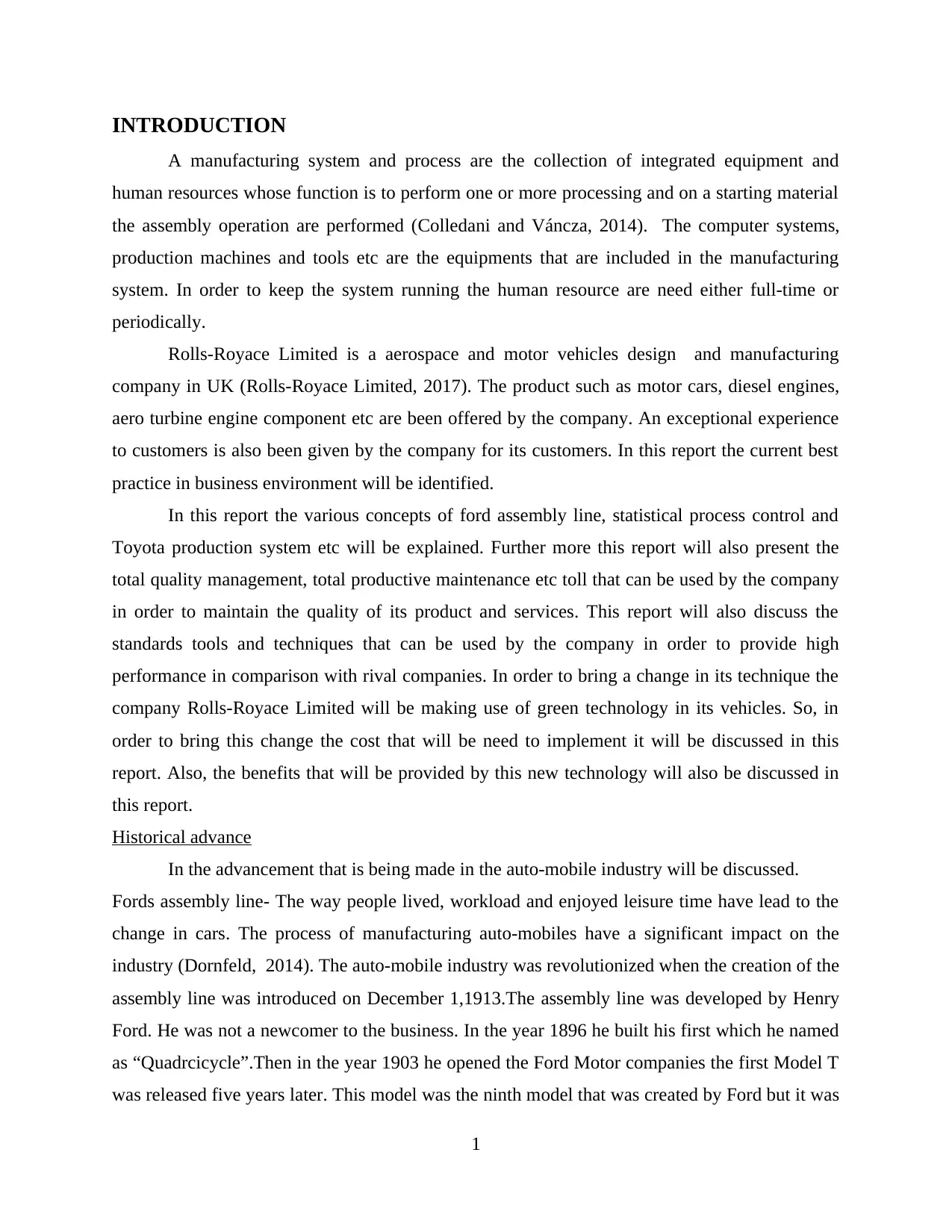
INTRODUCTION
A manufacturing system and process are the collection of integrated equipment and
human resources whose function is to perform one or more processing and on a starting material
the assembly operation are performed (Colledani and Váncza, 2014). The computer systems,
production machines and tools etc are the equipments that are included in the manufacturing
system. In order to keep the system running the human resource are need either full-time or
periodically.
Rolls-Royace Limited is a aerospace and motor vehicles design and manufacturing
company in UK (Rolls-Royace Limited, 2017). The product such as motor cars, diesel engines,
aero turbine engine component etc are been offered by the company. An exceptional experience
to customers is also been given by the company for its customers. In this report the current best
practice in business environment will be identified.
In this report the various concepts of ford assembly line, statistical process control and
Toyota production system etc will be explained. Further more this report will also present the
total quality management, total productive maintenance etc toll that can be used by the company
in order to maintain the quality of its product and services. This report will also discuss the
standards tools and techniques that can be used by the company in order to provide high
performance in comparison with rival companies. In order to bring a change in its technique the
company Rolls-Royace Limited will be making use of green technology in its vehicles. So, in
order to bring this change the cost that will be need to implement it will be discussed in this
report. Also, the benefits that will be provided by this new technology will also be discussed in
this report.
Historical advance
In the advancement that is being made in the auto-mobile industry will be discussed.
Fords assembly line- The way people lived, workload and enjoyed leisure time have lead to the
change in cars. The process of manufacturing auto-mobiles have a significant impact on the
industry (Dornfeld, 2014). The auto-mobile industry was revolutionized when the creation of the
assembly line was introduced on December 1,1913.The assembly line was developed by Henry
Ford. He was not a newcomer to the business. In the year 1896 he built his first which he named
as “Quadrcicycle”.Then in the year 1903 he opened the Ford Motor companies the first Model T
was released five years later. This model was the ninth model that was created by Ford but it was
1
A manufacturing system and process are the collection of integrated equipment and
human resources whose function is to perform one or more processing and on a starting material
the assembly operation are performed (Colledani and Váncza, 2014). The computer systems,
production machines and tools etc are the equipments that are included in the manufacturing
system. In order to keep the system running the human resource are need either full-time or
periodically.
Rolls-Royace Limited is a aerospace and motor vehicles design and manufacturing
company in UK (Rolls-Royace Limited, 2017). The product such as motor cars, diesel engines,
aero turbine engine component etc are been offered by the company. An exceptional experience
to customers is also been given by the company for its customers. In this report the current best
practice in business environment will be identified.
In this report the various concepts of ford assembly line, statistical process control and
Toyota production system etc will be explained. Further more this report will also present the
total quality management, total productive maintenance etc toll that can be used by the company
in order to maintain the quality of its product and services. This report will also discuss the
standards tools and techniques that can be used by the company in order to provide high
performance in comparison with rival companies. In order to bring a change in its technique the
company Rolls-Royace Limited will be making use of green technology in its vehicles. So, in
order to bring this change the cost that will be need to implement it will be discussed in this
report. Also, the benefits that will be provided by this new technology will also be discussed in
this report.
Historical advance
In the advancement that is being made in the auto-mobile industry will be discussed.
Fords assembly line- The way people lived, workload and enjoyed leisure time have lead to the
change in cars. The process of manufacturing auto-mobiles have a significant impact on the
industry (Dornfeld, 2014). The auto-mobile industry was revolutionized when the creation of the
assembly line was introduced on December 1,1913.The assembly line was developed by Henry
Ford. He was not a newcomer to the business. In the year 1896 he built his first which he named
as “Quadrcicycle”.Then in the year 1903 he opened the Ford Motor companies the first Model T
was released five years later. This model was the ninth model that was created by Ford but it was
1
⊘ This is a preview!⊘
Do you want full access?
Subscribe today to unlock all pages.

Trusted by 1+ million students worldwide
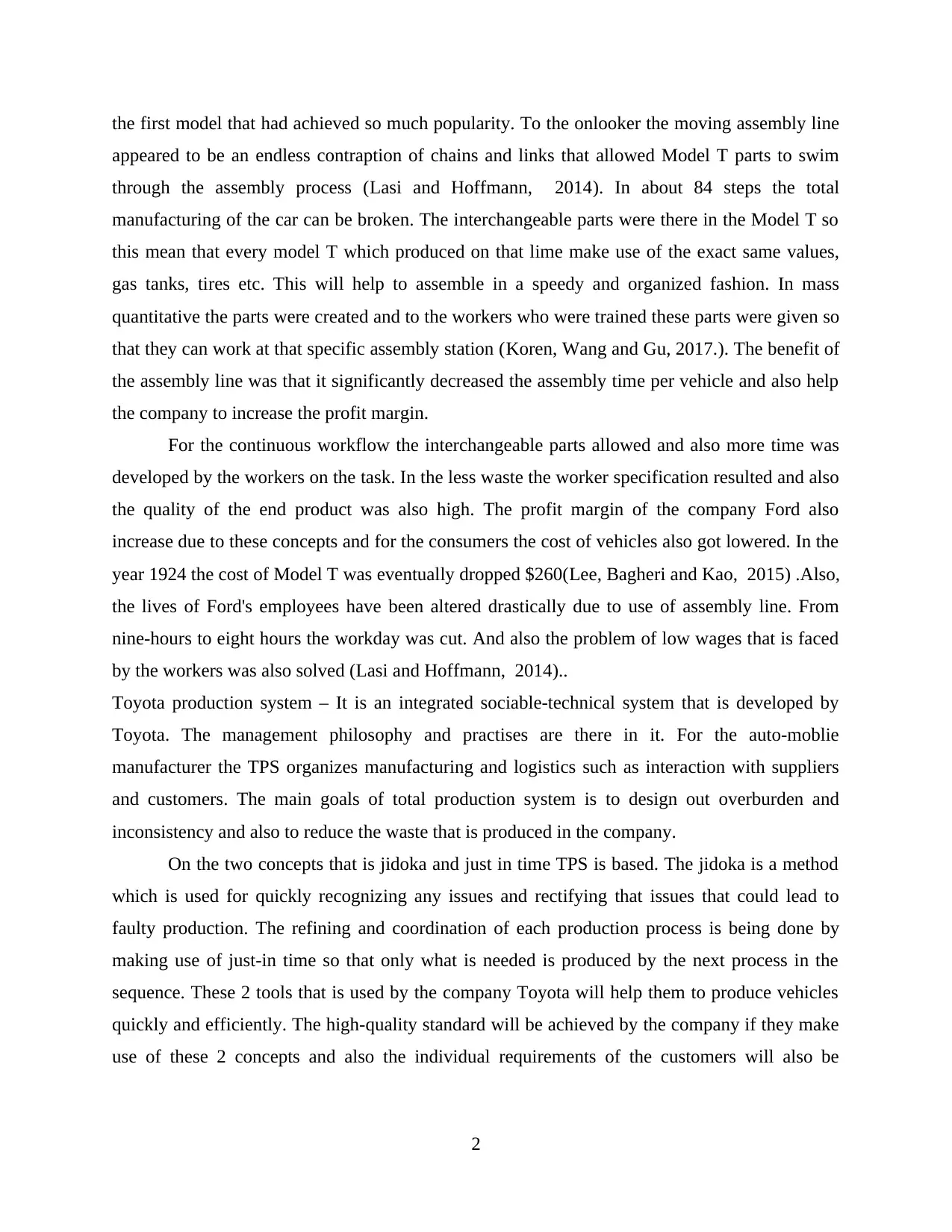
the first model that had achieved so much popularity. To the onlooker the moving assembly line
appeared to be an endless contraption of chains and links that allowed Model T parts to swim
through the assembly process (Lasi and Hoffmann, 2014). In about 84 steps the total
manufacturing of the car can be broken. The interchangeable parts were there in the Model T so
this mean that every model T which produced on that lime make use of the exact same values,
gas tanks, tires etc. This will help to assemble in a speedy and organized fashion. In mass
quantitative the parts were created and to the workers who were trained these parts were given so
that they can work at that specific assembly station (Koren, Wang and Gu, 2017.). The benefit of
the assembly line was that it significantly decreased the assembly time per vehicle and also help
the company to increase the profit margin.
For the continuous workflow the interchangeable parts allowed and also more time was
developed by the workers on the task. In the less waste the worker specification resulted and also
the quality of the end product was also high. The profit margin of the company Ford also
increase due to these concepts and for the consumers the cost of vehicles also got lowered. In the
year 1924 the cost of Model T was eventually dropped $260(Lee, Bagheri and Kao, 2015) .Also,
the lives of Ford's employees have been altered drastically due to use of assembly line. From
nine-hours to eight hours the workday was cut. And also the problem of low wages that is faced
by the workers was also solved (Lasi and Hoffmann, 2014)..
Toyota production system – It is an integrated sociable-technical system that is developed by
Toyota. The management philosophy and practises are there in it. For the auto-moblie
manufacturer the TPS organizes manufacturing and logistics such as interaction with suppliers
and customers. The main goals of total production system is to design out overburden and
inconsistency and also to reduce the waste that is produced in the company.
On the two concepts that is jidoka and just in time TPS is based. The jidoka is a method
which is used for quickly recognizing any issues and rectifying that issues that could lead to
faulty production. The refining and coordination of each production process is being done by
making use of just-in time so that only what is needed is produced by the next process in the
sequence. These 2 tools that is used by the company Toyota will help them to produce vehicles
quickly and efficiently. The high-quality standard will be achieved by the company if they make
use of these 2 concepts and also the individual requirements of the customers will also be
2
appeared to be an endless contraption of chains and links that allowed Model T parts to swim
through the assembly process (Lasi and Hoffmann, 2014). In about 84 steps the total
manufacturing of the car can be broken. The interchangeable parts were there in the Model T so
this mean that every model T which produced on that lime make use of the exact same values,
gas tanks, tires etc. This will help to assemble in a speedy and organized fashion. In mass
quantitative the parts were created and to the workers who were trained these parts were given so
that they can work at that specific assembly station (Koren, Wang and Gu, 2017.). The benefit of
the assembly line was that it significantly decreased the assembly time per vehicle and also help
the company to increase the profit margin.
For the continuous workflow the interchangeable parts allowed and also more time was
developed by the workers on the task. In the less waste the worker specification resulted and also
the quality of the end product was also high. The profit margin of the company Ford also
increase due to these concepts and for the consumers the cost of vehicles also got lowered. In the
year 1924 the cost of Model T was eventually dropped $260(Lee, Bagheri and Kao, 2015) .Also,
the lives of Ford's employees have been altered drastically due to use of assembly line. From
nine-hours to eight hours the workday was cut. And also the problem of low wages that is faced
by the workers was also solved (Lasi and Hoffmann, 2014)..
Toyota production system – It is an integrated sociable-technical system that is developed by
Toyota. The management philosophy and practises are there in it. For the auto-moblie
manufacturer the TPS organizes manufacturing and logistics such as interaction with suppliers
and customers. The main goals of total production system is to design out overburden and
inconsistency and also to reduce the waste that is produced in the company.
On the two concepts that is jidoka and just in time TPS is based. The jidoka is a method
which is used for quickly recognizing any issues and rectifying that issues that could lead to
faulty production. The refining and coordination of each production process is being done by
making use of just-in time so that only what is needed is produced by the next process in the
sequence. These 2 tools that is used by the company Toyota will help them to produce vehicles
quickly and efficiently. The high-quality standard will be achieved by the company if they make
use of these 2 concepts and also the individual requirements of the customers will also be
2
Paraphrase This Document
Need a fresh take? Get an instant paraphrase of this document with our AI Paraphraser
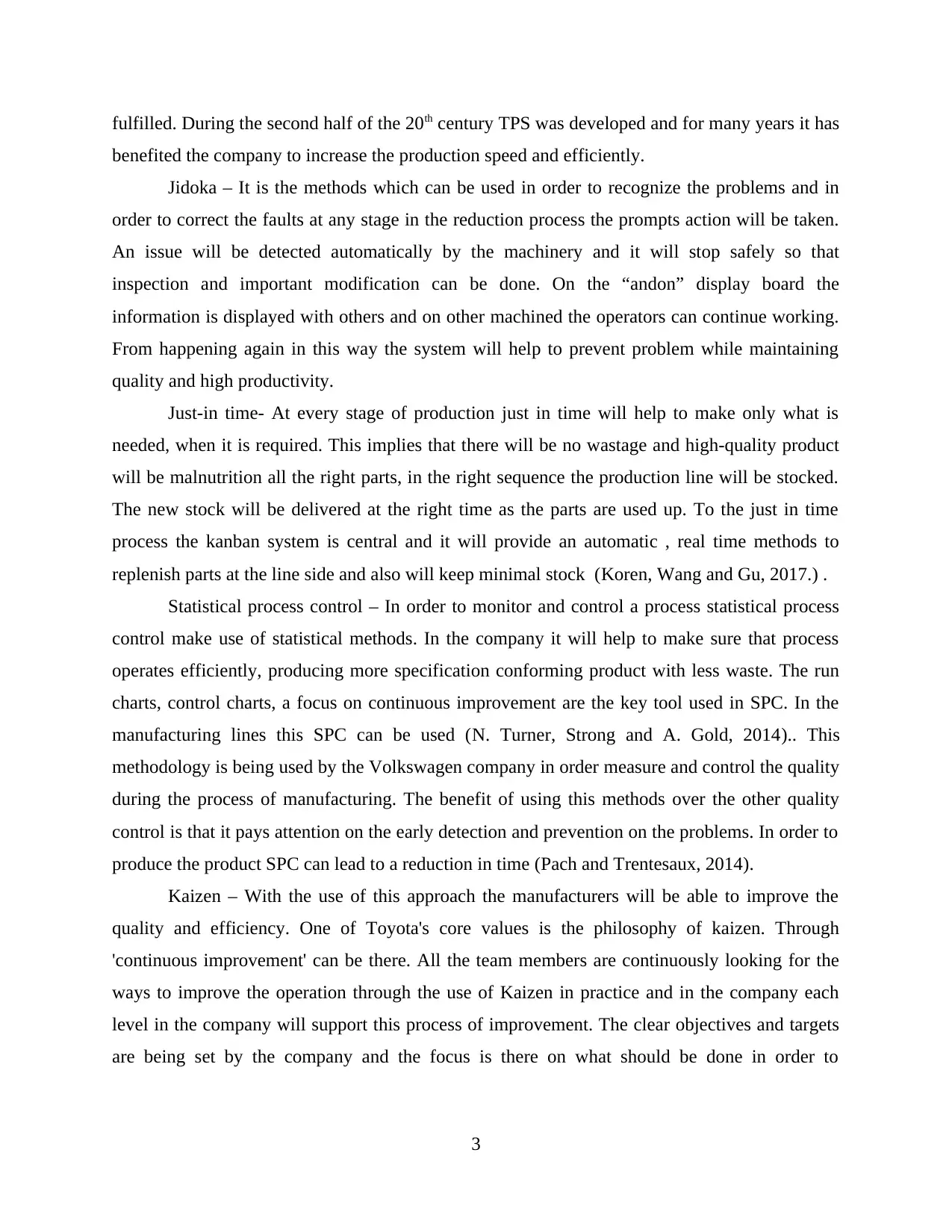
fulfilled. During the second half of the 20th century TPS was developed and for many years it has
benefited the company to increase the production speed and efficiently.
Jidoka – It is the methods which can be used in order to recognize the problems and in
order to correct the faults at any stage in the reduction process the prompts action will be taken.
An issue will be detected automatically by the machinery and it will stop safely so that
inspection and important modification can be done. On the “andon” display board the
information is displayed with others and on other machined the operators can continue working.
From happening again in this way the system will help to prevent problem while maintaining
quality and high productivity.
Just-in time- At every stage of production just in time will help to make only what is
needed, when it is required. This implies that there will be no wastage and high-quality product
will be malnutrition all the right parts, in the right sequence the production line will be stocked.
The new stock will be delivered at the right time as the parts are used up. To the just in time
process the kanban system is central and it will provide an automatic , real time methods to
replenish parts at the line side and also will keep minimal stock (Koren, Wang and Gu, 2017.) .
Statistical process control – In order to monitor and control a process statistical process
control make use of statistical methods. In the company it will help to make sure that process
operates efficiently, producing more specification conforming product with less waste. The run
charts, control charts, a focus on continuous improvement are the key tool used in SPC. In the
manufacturing lines this SPC can be used (N. Turner, Strong and A. Gold, 2014).. This
methodology is being used by the Volkswagen company in order measure and control the quality
during the process of manufacturing. The benefit of using this methods over the other quality
control is that it pays attention on the early detection and prevention on the problems. In order to
produce the product SPC can lead to a reduction in time (Pach and Trentesaux, 2014).
Kaizen – With the use of this approach the manufacturers will be able to improve the
quality and efficiency. One of Toyota's core values is the philosophy of kaizen. Through
'continuous improvement' can be there. All the team members are continuously looking for the
ways to improve the operation through the use of Kaizen in practice and in the company each
level in the company will support this process of improvement. The clear objectives and targets
are being set by the company and the focus is there on what should be done in order to
3
benefited the company to increase the production speed and efficiently.
Jidoka – It is the methods which can be used in order to recognize the problems and in
order to correct the faults at any stage in the reduction process the prompts action will be taken.
An issue will be detected automatically by the machinery and it will stop safely so that
inspection and important modification can be done. On the “andon” display board the
information is displayed with others and on other machined the operators can continue working.
From happening again in this way the system will help to prevent problem while maintaining
quality and high productivity.
Just-in time- At every stage of production just in time will help to make only what is
needed, when it is required. This implies that there will be no wastage and high-quality product
will be malnutrition all the right parts, in the right sequence the production line will be stocked.
The new stock will be delivered at the right time as the parts are used up. To the just in time
process the kanban system is central and it will provide an automatic , real time methods to
replenish parts at the line side and also will keep minimal stock (Koren, Wang and Gu, 2017.) .
Statistical process control – In order to monitor and control a process statistical process
control make use of statistical methods. In the company it will help to make sure that process
operates efficiently, producing more specification conforming product with less waste. The run
charts, control charts, a focus on continuous improvement are the key tool used in SPC. In the
manufacturing lines this SPC can be used (N. Turner, Strong and A. Gold, 2014).. This
methodology is being used by the Volkswagen company in order measure and control the quality
during the process of manufacturing. The benefit of using this methods over the other quality
control is that it pays attention on the early detection and prevention on the problems. In order to
produce the product SPC can lead to a reduction in time (Pach and Trentesaux, 2014).
Kaizen – With the use of this approach the manufacturers will be able to improve the
quality and efficiency. One of Toyota's core values is the philosophy of kaizen. Through
'continuous improvement' can be there. All the team members are continuously looking for the
ways to improve the operation through the use of Kaizen in practice and in the company each
level in the company will support this process of improvement. The clear objectives and targets
are being set by the company and the focus is there on what should be done in order to
3
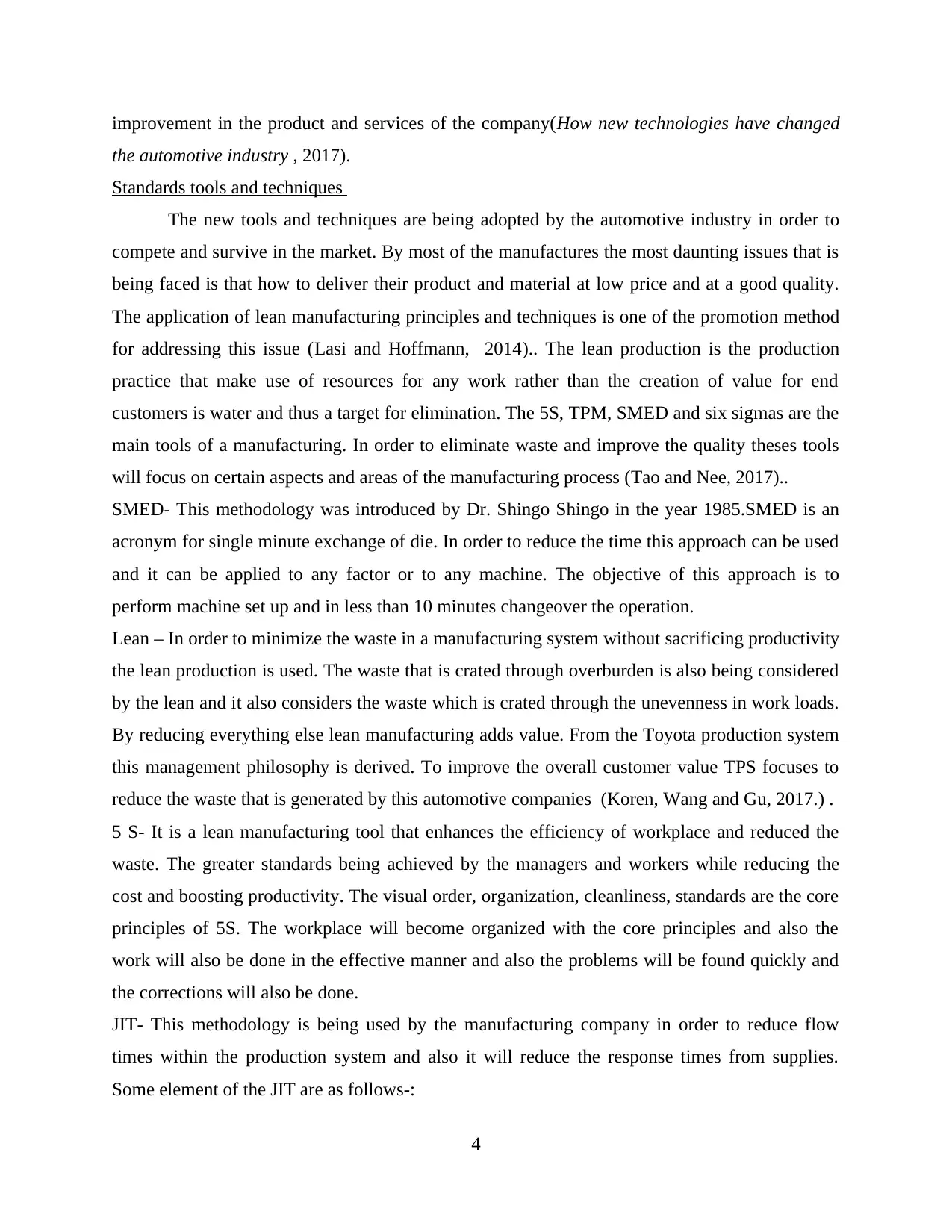
improvement in the product and services of the company(How new technologies have changed
the automotive industry , 2017).
Standards tools and techniques
The new tools and techniques are being adopted by the automotive industry in order to
compete and survive in the market. By most of the manufactures the most daunting issues that is
being faced is that how to deliver their product and material at low price and at a good quality.
The application of lean manufacturing principles and techniques is one of the promotion method
for addressing this issue (Lasi and Hoffmann, 2014).. The lean production is the production
practice that make use of resources for any work rather than the creation of value for end
customers is water and thus a target for elimination. The 5S, TPM, SMED and six sigmas are the
main tools of a manufacturing. In order to eliminate waste and improve the quality theses tools
will focus on certain aspects and areas of the manufacturing process (Tao and Nee, 2017)..
SMED- This methodology was introduced by Dr. Shingo Shingo in the year 1985.SMED is an
acronym for single minute exchange of die. In order to reduce the time this approach can be used
and it can be applied to any factor or to any machine. The objective of this approach is to
perform machine set up and in less than 10 minutes changeover the operation.
Lean – In order to minimize the waste in a manufacturing system without sacrificing productivity
the lean production is used. The waste that is crated through overburden is also being considered
by the lean and it also considers the waste which is crated through the unevenness in work loads.
By reducing everything else lean manufacturing adds value. From the Toyota production system
this management philosophy is derived. To improve the overall customer value TPS focuses to
reduce the waste that is generated by this automotive companies (Koren, Wang and Gu, 2017.) .
5 S- It is a lean manufacturing tool that enhances the efficiency of workplace and reduced the
waste. The greater standards being achieved by the managers and workers while reducing the
cost and boosting productivity. The visual order, organization, cleanliness, standards are the core
principles of 5S. The workplace will become organized with the core principles and also the
work will also be done in the effective manner and also the problems will be found quickly and
the corrections will also be done.
JIT- This methodology is being used by the manufacturing company in order to reduce flow
times within the production system and also it will reduce the response times from supplies.
Some element of the JIT are as follows-:
4
the automotive industry , 2017).
Standards tools and techniques
The new tools and techniques are being adopted by the automotive industry in order to
compete and survive in the market. By most of the manufactures the most daunting issues that is
being faced is that how to deliver their product and material at low price and at a good quality.
The application of lean manufacturing principles and techniques is one of the promotion method
for addressing this issue (Lasi and Hoffmann, 2014).. The lean production is the production
practice that make use of resources for any work rather than the creation of value for end
customers is water and thus a target for elimination. The 5S, TPM, SMED and six sigmas are the
main tools of a manufacturing. In order to eliminate waste and improve the quality theses tools
will focus on certain aspects and areas of the manufacturing process (Tao and Nee, 2017)..
SMED- This methodology was introduced by Dr. Shingo Shingo in the year 1985.SMED is an
acronym for single minute exchange of die. In order to reduce the time this approach can be used
and it can be applied to any factor or to any machine. The objective of this approach is to
perform machine set up and in less than 10 minutes changeover the operation.
Lean – In order to minimize the waste in a manufacturing system without sacrificing productivity
the lean production is used. The waste that is crated through overburden is also being considered
by the lean and it also considers the waste which is crated through the unevenness in work loads.
By reducing everything else lean manufacturing adds value. From the Toyota production system
this management philosophy is derived. To improve the overall customer value TPS focuses to
reduce the waste that is generated by this automotive companies (Koren, Wang and Gu, 2017.) .
5 S- It is a lean manufacturing tool that enhances the efficiency of workplace and reduced the
waste. The greater standards being achieved by the managers and workers while reducing the
cost and boosting productivity. The visual order, organization, cleanliness, standards are the core
principles of 5S. The workplace will become organized with the core principles and also the
work will also be done in the effective manner and also the problems will be found quickly and
the corrections will also be done.
JIT- This methodology is being used by the manufacturing company in order to reduce flow
times within the production system and also it will reduce the response times from supplies.
Some element of the JIT are as follows-:
4
⊘ This is a preview!⊘
Do you want full access?
Subscribe today to unlock all pages.

Trusted by 1+ million students worldwide
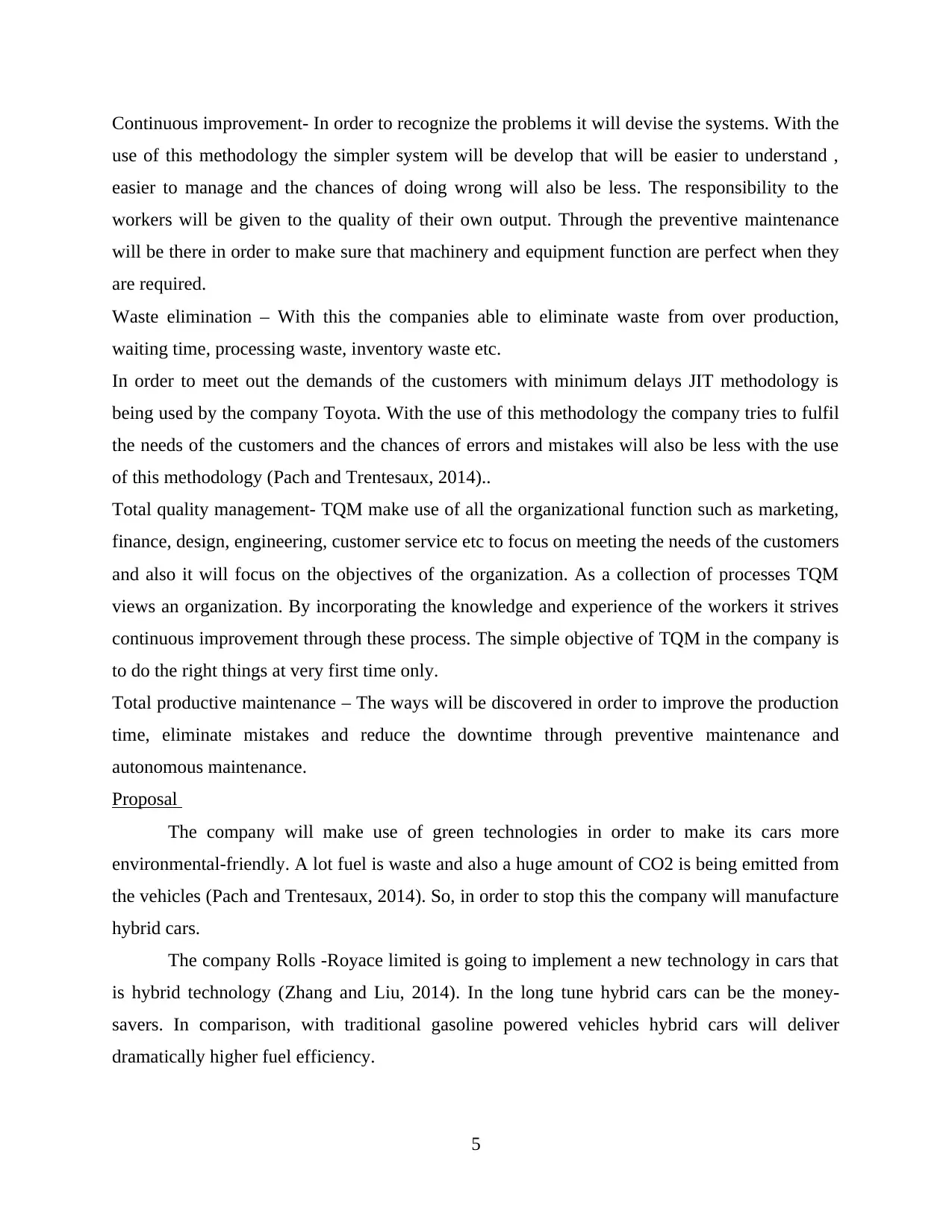
Continuous improvement- In order to recognize the problems it will devise the systems. With the
use of this methodology the simpler system will be develop that will be easier to understand ,
easier to manage and the chances of doing wrong will also be less. The responsibility to the
workers will be given to the quality of their own output. Through the preventive maintenance
will be there in order to make sure that machinery and equipment function are perfect when they
are required.
Waste elimination – With this the companies able to eliminate waste from over production,
waiting time, processing waste, inventory waste etc.
In order to meet out the demands of the customers with minimum delays JIT methodology is
being used by the company Toyota. With the use of this methodology the company tries to fulfil
the needs of the customers and the chances of errors and mistakes will also be less with the use
of this methodology (Pach and Trentesaux, 2014)..
Total quality management- TQM make use of all the organizational function such as marketing,
finance, design, engineering, customer service etc to focus on meeting the needs of the customers
and also it will focus on the objectives of the organization. As a collection of processes TQM
views an organization. By incorporating the knowledge and experience of the workers it strives
continuous improvement through these process. The simple objective of TQM in the company is
to do the right things at very first time only.
Total productive maintenance – The ways will be discovered in order to improve the production
time, eliminate mistakes and reduce the downtime through preventive maintenance and
autonomous maintenance.
Proposal
The company will make use of green technologies in order to make its cars more
environmental-friendly. A lot fuel is waste and also a huge amount of CO2 is being emitted from
the vehicles (Pach and Trentesaux, 2014). So, in order to stop this the company will manufacture
hybrid cars.
The company Rolls -Royace limited is going to implement a new technology in cars that
is hybrid technology (Zhang and Liu, 2014). In the long tune hybrid cars can be the money-
savers. In comparison, with traditional gasoline powered vehicles hybrid cars will deliver
dramatically higher fuel efficiency.
5
use of this methodology the simpler system will be develop that will be easier to understand ,
easier to manage and the chances of doing wrong will also be less. The responsibility to the
workers will be given to the quality of their own output. Through the preventive maintenance
will be there in order to make sure that machinery and equipment function are perfect when they
are required.
Waste elimination – With this the companies able to eliminate waste from over production,
waiting time, processing waste, inventory waste etc.
In order to meet out the demands of the customers with minimum delays JIT methodology is
being used by the company Toyota. With the use of this methodology the company tries to fulfil
the needs of the customers and the chances of errors and mistakes will also be less with the use
of this methodology (Pach and Trentesaux, 2014)..
Total quality management- TQM make use of all the organizational function such as marketing,
finance, design, engineering, customer service etc to focus on meeting the needs of the customers
and also it will focus on the objectives of the organization. As a collection of processes TQM
views an organization. By incorporating the knowledge and experience of the workers it strives
continuous improvement through these process. The simple objective of TQM in the company is
to do the right things at very first time only.
Total productive maintenance – The ways will be discovered in order to improve the production
time, eliminate mistakes and reduce the downtime through preventive maintenance and
autonomous maintenance.
Proposal
The company will make use of green technologies in order to make its cars more
environmental-friendly. A lot fuel is waste and also a huge amount of CO2 is being emitted from
the vehicles (Pach and Trentesaux, 2014). So, in order to stop this the company will manufacture
hybrid cars.
The company Rolls -Royace limited is going to implement a new technology in cars that
is hybrid technology (Zhang and Liu, 2014). In the long tune hybrid cars can be the money-
savers. In comparison, with traditional gasoline powered vehicles hybrid cars will deliver
dramatically higher fuel efficiency.
5
Paraphrase This Document
Need a fresh take? Get an instant paraphrase of this document with our AI Paraphraser
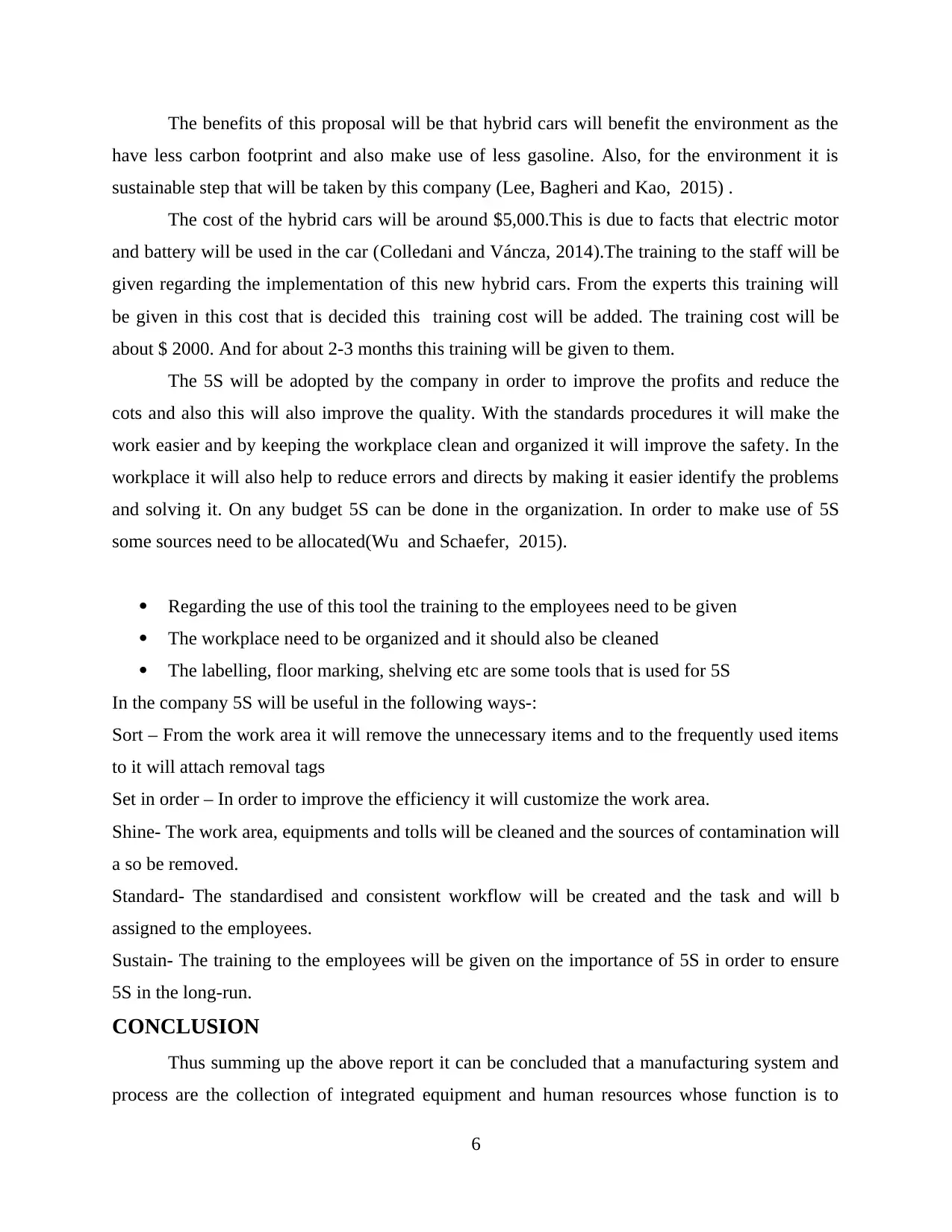
The benefits of this proposal will be that hybrid cars will benefit the environment as the
have less carbon footprint and also make use of less gasoline. Also, for the environment it is
sustainable step that will be taken by this company (Lee, Bagheri and Kao, 2015) .
The cost of the hybrid cars will be around $5,000.This is due to facts that electric motor
and battery will be used in the car (Colledani and Váncza, 2014).The training to the staff will be
given regarding the implementation of this new hybrid cars. From the experts this training will
be given in this cost that is decided this training cost will be added. The training cost will be
about $ 2000. And for about 2-3 months this training will be given to them.
The 5S will be adopted by the company in order to improve the profits and reduce the
cots and also this will also improve the quality. With the standards procedures it will make the
work easier and by keeping the workplace clean and organized it will improve the safety. In the
workplace it will also help to reduce errors and directs by making it easier identify the problems
and solving it. On any budget 5S can be done in the organization. In order to make use of 5S
some sources need to be allocated(Wu and Schaefer, 2015).
Regarding the use of this tool the training to the employees need to be given
The workplace need to be organized and it should also be cleaned
The labelling, floor marking, shelving etc are some tools that is used for 5S
In the company 5S will be useful in the following ways-:
Sort – From the work area it will remove the unnecessary items and to the frequently used items
to it will attach removal tags
Set in order – In order to improve the efficiency it will customize the work area.
Shine- The work area, equipments and tolls will be cleaned and the sources of contamination will
a so be removed.
Standard- The standardised and consistent workflow will be created and the task and will b
assigned to the employees.
Sustain- The training to the employees will be given on the importance of 5S in order to ensure
5S in the long-run.
CONCLUSION
Thus summing up the above report it can be concluded that a manufacturing system and
process are the collection of integrated equipment and human resources whose function is to
6
have less carbon footprint and also make use of less gasoline. Also, for the environment it is
sustainable step that will be taken by this company (Lee, Bagheri and Kao, 2015) .
The cost of the hybrid cars will be around $5,000.This is due to facts that electric motor
and battery will be used in the car (Colledani and Váncza, 2014).The training to the staff will be
given regarding the implementation of this new hybrid cars. From the experts this training will
be given in this cost that is decided this training cost will be added. The training cost will be
about $ 2000. And for about 2-3 months this training will be given to them.
The 5S will be adopted by the company in order to improve the profits and reduce the
cots and also this will also improve the quality. With the standards procedures it will make the
work easier and by keeping the workplace clean and organized it will improve the safety. In the
workplace it will also help to reduce errors and directs by making it easier identify the problems
and solving it. On any budget 5S can be done in the organization. In order to make use of 5S
some sources need to be allocated(Wu and Schaefer, 2015).
Regarding the use of this tool the training to the employees need to be given
The workplace need to be organized and it should also be cleaned
The labelling, floor marking, shelving etc are some tools that is used for 5S
In the company 5S will be useful in the following ways-:
Sort – From the work area it will remove the unnecessary items and to the frequently used items
to it will attach removal tags
Set in order – In order to improve the efficiency it will customize the work area.
Shine- The work area, equipments and tolls will be cleaned and the sources of contamination will
a so be removed.
Standard- The standardised and consistent workflow will be created and the task and will b
assigned to the employees.
Sustain- The training to the employees will be given on the importance of 5S in order to ensure
5S in the long-run.
CONCLUSION
Thus summing up the above report it can be concluded that a manufacturing system and
process are the collection of integrated equipment and human resources whose function is to
6
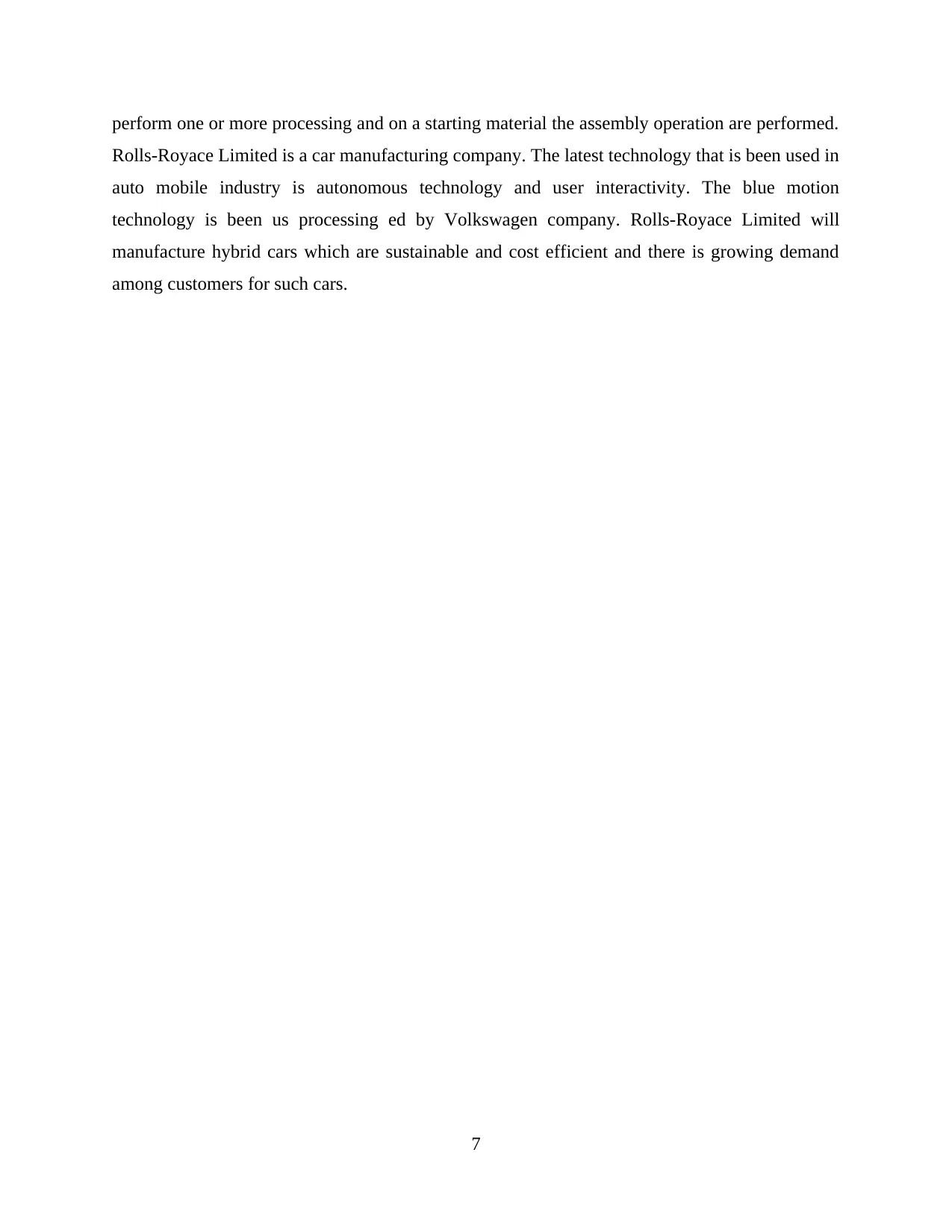
perform one or more processing and on a starting material the assembly operation are performed.
Rolls-Royace Limited is a car manufacturing company. The latest technology that is been used in
auto mobile industry is autonomous technology and user interactivity. The blue motion
technology is been us processing ed by Volkswagen company. Rolls-Royace Limited will
manufacture hybrid cars which are sustainable and cost efficient and there is growing demand
among customers for such cars.
7
Rolls-Royace Limited is a car manufacturing company. The latest technology that is been used in
auto mobile industry is autonomous technology and user interactivity. The blue motion
technology is been us processing ed by Volkswagen company. Rolls-Royace Limited will
manufacture hybrid cars which are sustainable and cost efficient and there is growing demand
among customers for such cars.
7
⊘ This is a preview!⊘
Do you want full access?
Subscribe today to unlock all pages.

Trusted by 1+ million students worldwide
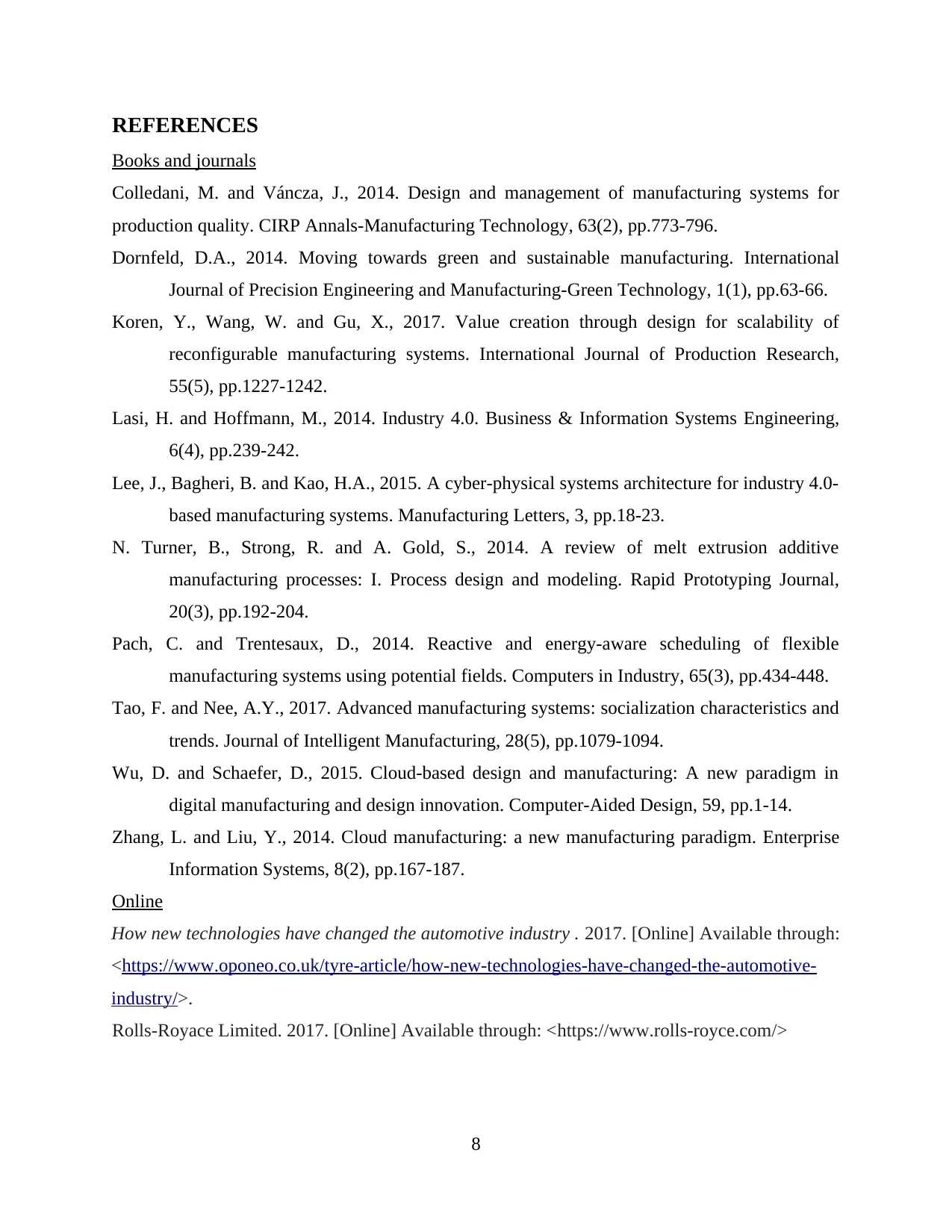
REFERENCES
Books and journals
Colledani, M. and Váncza, J., 2014. Design and management of manufacturing systems for
production quality. CIRP Annals-Manufacturing Technology, 63(2), pp.773-796.
Dornfeld, D.A., 2014. Moving towards green and sustainable manufacturing. International
Journal of Precision Engineering and Manufacturing-Green Technology, 1(1), pp.63-66.
Koren, Y., Wang, W. and Gu, X., 2017. Value creation through design for scalability of
reconfigurable manufacturing systems. International Journal of Production Research,
55(5), pp.1227-1242.
Lasi, H. and Hoffmann, M., 2014. Industry 4.0. Business & Information Systems Engineering,
6(4), pp.239-242.
Lee, J., Bagheri, B. and Kao, H.A., 2015. A cyber-physical systems architecture for industry 4.0-
based manufacturing systems. Manufacturing Letters, 3, pp.18-23.
N. Turner, B., Strong, R. and A. Gold, S., 2014. A review of melt extrusion additive
manufacturing processes: I. Process design and modeling. Rapid Prototyping Journal,
20(3), pp.192-204.
Pach, C. and Trentesaux, D., 2014. Reactive and energy-aware scheduling of flexible
manufacturing systems using potential fields. Computers in Industry, 65(3), pp.434-448.
Tao, F. and Nee, A.Y., 2017. Advanced manufacturing systems: socialization characteristics and
trends. Journal of Intelligent Manufacturing, 28(5), pp.1079-1094.
Wu, D. and Schaefer, D., 2015. Cloud-based design and manufacturing: A new paradigm in
digital manufacturing and design innovation. Computer-Aided Design, 59, pp.1-14.
Zhang, L. and Liu, Y., 2014. Cloud manufacturing: a new manufacturing paradigm. Enterprise
Information Systems, 8(2), pp.167-187.
Online
How new technologies have changed the automotive industry . 2017. [Online] Available through:
<https://www.oponeo.co.uk/tyre-article/how-new-technologies-have-changed-the-automotive-
industry/>.
Rolls-Royace Limited. 2017. [Online] Available through: <https://www.rolls-royce.com/>
8
Books and journals
Colledani, M. and Váncza, J., 2014. Design and management of manufacturing systems for
production quality. CIRP Annals-Manufacturing Technology, 63(2), pp.773-796.
Dornfeld, D.A., 2014. Moving towards green and sustainable manufacturing. International
Journal of Precision Engineering and Manufacturing-Green Technology, 1(1), pp.63-66.
Koren, Y., Wang, W. and Gu, X., 2017. Value creation through design for scalability of
reconfigurable manufacturing systems. International Journal of Production Research,
55(5), pp.1227-1242.
Lasi, H. and Hoffmann, M., 2014. Industry 4.0. Business & Information Systems Engineering,
6(4), pp.239-242.
Lee, J., Bagheri, B. and Kao, H.A., 2015. A cyber-physical systems architecture for industry 4.0-
based manufacturing systems. Manufacturing Letters, 3, pp.18-23.
N. Turner, B., Strong, R. and A. Gold, S., 2014. A review of melt extrusion additive
manufacturing processes: I. Process design and modeling. Rapid Prototyping Journal,
20(3), pp.192-204.
Pach, C. and Trentesaux, D., 2014. Reactive and energy-aware scheduling of flexible
manufacturing systems using potential fields. Computers in Industry, 65(3), pp.434-448.
Tao, F. and Nee, A.Y., 2017. Advanced manufacturing systems: socialization characteristics and
trends. Journal of Intelligent Manufacturing, 28(5), pp.1079-1094.
Wu, D. and Schaefer, D., 2015. Cloud-based design and manufacturing: A new paradigm in
digital manufacturing and design innovation. Computer-Aided Design, 59, pp.1-14.
Zhang, L. and Liu, Y., 2014. Cloud manufacturing: a new manufacturing paradigm. Enterprise
Information Systems, 8(2), pp.167-187.
Online
How new technologies have changed the automotive industry . 2017. [Online] Available through:
<https://www.oponeo.co.uk/tyre-article/how-new-technologies-have-changed-the-automotive-
industry/>.
Rolls-Royace Limited. 2017. [Online] Available through: <https://www.rolls-royce.com/>
8
1 out of 10
Related Documents
Your All-in-One AI-Powered Toolkit for Academic Success.
+13062052269
info@desklib.com
Available 24*7 on WhatsApp / Email
![[object Object]](/_next/static/media/star-bottom.7253800d.svg)
Unlock your academic potential
Copyright © 2020–2025 A2Z Services. All Rights Reserved. Developed and managed by ZUCOL.




